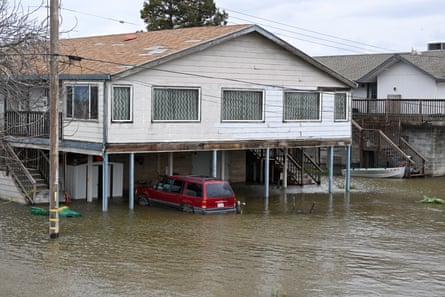The start of spring offered little reprieve for California as another atmospheric river doused the saturated state with more rain and snow. Five deaths have been linked to the storm across the Bay Area, after thrashing winds toppled trees and branches and thousands were left in the dark across the state due to widespread power outages.
California’s unexpected siege of wet weather after years of drought has loaded mountains with so much snow that roofs have been crushed and crews have struggled to keep highways clear of avalanches. Tuesday’s storm, which came on the first full day of spring following the state’s extraordinary winter, was the result of a Pacific low pressure system interacting with California’s 12th atmospheric river since late December, according to the National Weather Service, which warned that flood risks remain across the region into Wednesday.

But along with a slew of dangers posed by the rising waters, the storms unleashed furious winds that wreaked havoc across the state, with warnings issued by officials from San Francisco to San Diego.
“Trees are down everywhere,” resident Frank Kuhr said as he waited for officials to remove large redwoods that were blocking a highway near his home in Santa Cruz county. Gusts up to 80 mph (122kph) blew through the sodden mountain communities pulling down branches and power lines. “The wind has been unbelievable,” he said. “Branches were flying through the air, and folks could hear trees just falling and cracking.”
The blustery conditions have posed significant dangers during the storms, ripping trees up at their roots and blowing down branches. Two people died in the hospital in San Francisco of injuries from separate tree-impacts and a man in Oakland was killed when a tree fell on his tent, officials reported.
In the Bay Area community of Portola Valley, a man driving a sewer truck was killed when a tree fell on to the vehicle, the California highway patrol said. And in the community of Rossmoor, a driver was injured and a passenger died after a large tree fell on to a car, the Contra Costa county fire protection district said.
In the Monterey Bay region, the severe windsblasted Santa Cruz county with wind gusts up to 80mph (129km/h) at midday, as ocean foam blew across the roadways like large snowflakes along the coastline of the Monterey Bay national marine sanctuary.

On Tuesday, in San Francisco, the billowing winds were so strong pedestrians struggled to walk, and may have even caused a high-rise window to shatter, raining glass on the street below. “High winds have led to more shards of falling window glass from another building at 50 California,” supervisor Aaron Peskin said in a tweet, thanking emergency responders. By Wednesday afternoon, officials confirmed that windows that stretched across 20 stories of a skyscraper had also splintered due to the severe winds. Four buildings were impacted and then tagged for violations, as officials tried to assure locals and visitors that it was safe to walk through the area.
The gale-force winds that swept through the region also toppled a big rig truck Tuesday afternoon, blocking the east-bound lanes of the Bay Bridge into the evening.
Across the Bay, near the village of Porta Costa, an Amtrak commuter train carrying 55 passengers struck a downed tree and derailed. The train remained upright and nobody was injured, Amtrak and fire officials said.
The National Weather Service is investigating reports that tornadoes developed in southern California on Tuesday evening and Wednesday afternoon, as videos surfaced online showing a swirling dark funnel that tore through the tops of buildings.
“NWS Oxnard currently plans to send a damage survey team to southeast Santa Barbara county where there were reports of a possible tornado that caused some damage to mobile homes,” the agency said in a statement released Wednesday. “In addition, a new report of possible tornado damage will be investigated from late this morning in the Montebello area.”
One person was injured and at least five buildings were damaged in the incident in Los Angeles county, according to ABC news, as the wild weather ripped through roofs and flung debris into the air.
Threats from the storm will weaken through Wednesday, the NWS reported, but risks remain for Californians, especially as the weather warms and the state’s significant snowpack begins to melt.

The Mammoth Mountain resort in the eastern Sierra Nevada announced that it will remain open for skiing and snowboarding at least through the end of July. With a season-to-date snowfall of 634in (16.1 meters) at the main lodge, it was likely just one storm away from breaking the all-time record of 668in (16.9 meters) set in the 2010-2011 season.
More than 114,200 households and businesses were still without power by Wednesday afternoon. Homes across the mountainous middle are still buried in white as displaced residents in flooded areas along the coast and in the central valley wait for waters to recede. Flood advisories remain in affect, even as the weather lulls in California, as rain and snowmelt may cause flooding on Wednesday in southern California and central Arizona, the National Weather Service warned.
The Associated Press contributed reporting

 1 year ago
49
1 year ago
49










 English (US)
English (US)